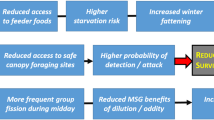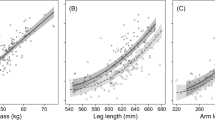Summary
We studied how age, body size and prior residency affected social dominance in the willow tit (Parus montanus) groups. The contribution of each variable was experimentally tested in unisexual two-bird trials, in which the birds were matched for all variables except the one studied. Large birds were dominant over smaller ones (Fig. 1). The effect of body size was more prominent in males than in females. Age had no influence on dominance. Residents became dominant more often than newcomers (Fig. 2). Adulthood or larger body size did not override the advantage of prior residency (Fig. 2). Therefore, the proximate reason for the age-dependent dominance seen in natural willow tit flocks is most likely the prior residency advantage of the adults. Factors connected with fighting ability (body size and age) seem to be less important than the time of establishment of rank, which may reflect the importance of resource value differences between residents and newcomers in this context. The advantage of residency might make it advantageous to be a member of a flock even as a subordinate, rather than being solitary.
Similar content being viewed by others
References
Arcese P, Smith JNM (1985) Phenotypic correlates and ecological consequences of dominance in song sparrows. J Anim Ecol 54:817–830
Cristol DA, Nolan V Jr, Ketterson ED (1990) Effect of prior residence on dominance status of dark-eyed juncos,Junco hyemalis. Anim Behav 40:580–586
De Laet JF (1985) Dominance and antipredator behaviour of great titsParus major: a field study. Ibis 127:372–377
Desrochers A, Hannon SJ, Nordin KE (1988) Winter survival and territory acquisition in a northern population of black-capped chickadees. Auk 105:727–736
Ekman J (1979a) Coherence, composition and territories of winter social groups of the willow titParus montanus and the crested titP. cristatus. Ornis Scand 10:56–68
Ekman J (1979b) Non-territorial willow titsParus montanus de Selys-Longchamp in late summer and early autumn. Ornis Scand 10:262–267
Ekman J (1987) Exposure and time use in willow tit flocks: the cost of subordination. Anim Behav 35:445–452
Ekman J (1989) Ecology of non-breeding social systems ofParus. Wilson Bull 101: 263–288
Ekman J, Askenmo C (1984) Social rank and habitat use in willow tit groups. Anim Behav 32:508–514
Ekman J, Cederholm G, Askenmo C (1981) Spacing and survival in winter groups of willow titParus montanus and crested titP. cristatus, a removal study. J Anim Ecol 50:1–9
Garnett MC (1981) Body size, its heritability and influence on juvenile survival among great tits,Parus major. Ibis 123:31–41
Hegner RE (1985) Dominance and anti-predator behaviour in blue tits (Parus caeruleus). Anim Behav 33:762–768
Haftorn S (1956) Contribution to the food biology of tits especially about storing of surplus food. Part III. The willow tit (Parus atricapillus L.). Kgl Norske Vidensk Selsk Skr 3:1–79
Hogstad O (1987) Social rank in winter flocks of willow tits,Parus montanus. Ibis 129: 1–9
Hogstad O (1988a) Social rank and antipredator behaviour of willow titsParus montanus in winter flocks. Ibis 130:45–56
Hogstad O (1988b) Rank-related resource access in winter flocks of willow titParus montanus. Ornis Scand 19:169–174
Hogstad O (1989a) Social organization and dominance behaviour in someParus species. Wilson Bull 101:254–262
Hogstad O (1989b) The role of juvenile willow tits,Parus montanus, in the regulation of winter flock size: an experimental study. Anim Behav 38:920–925
Hogstad O (1990) Winter floaters in willow titsParus montanus — a matter of choice or making the best of bad situation? In: Blondel J, Gosler A, Lebreton JD, McCleery R (eds) Population biology of passerine birds — an integraded approach (NATO ASI Series, Series G vol. 24). Springer, Berlin, pp 415–422
Holberton RL, Hanano R, Able KP (1990) Age-related dominance in male dark-eyed juncos: effects of plumage and prior residence. Anim Behav 40:573–579
Koivula K, Orell M (1988) Social rank and winter survival in the willow titParus montanus. Ornis Fenn 65:114–120
Laaksonen M, Lehikoinen E (1976) Age determination of willow and crested titParus montanus andP. cristatus. Ornis Fenn 53:9–14
Maynard Smith J, Parker GA (1976) The logic of asymmetric contests. Anim Behav 24:159–175
Nilsson J-Å (1989) Establishment of juvenile marsh tits in winter flocks: an experimental study. Anim Behav 38:586–595
Nilsson J-Å, Smith HG (1988) Effects of dispersal date on winter flock establishment and social dominance in marsh titsParus palustris. J Anim Ecol 57:917–928
Parker GA, Rubenstein DI (1981) Role assessment, reserve strategy, and acquisition of information in asymmetric animal conflicts. Anim Behav 29:221–240
Piper WH, Wiley RH (1989) Correlates of dominance in wintering white-throated sparrows: age, sex and location. Anim Behav 37:298–310
Popp JW (1987) Resource value and dominance among American goldfinches. Bird Behav 7:73–77
Pöysä H (1988) Feeding consequences of the dominance status in Great TitParus major groups. Ornis Fenn 65:69–75
Richner H (1989) Phenotypic correlates of dominance in carrion crows and their effects on access to food. Anim Behav 38:606–612
Sandell M, Smith HG (1991) Dominance, prior occupancy, and winter residency in the great tit (Parus major). Behav Ecol Sociobiol 29:147–152
Schneider KJ (1984) Dominance, predation, and optimal foraging in white-throated sparrow flocks. Ecology 65:1820–1827
Searcy WA (1979) Morphological correlates of dominance in captive male red-winged blackbirds. Condor 81:417–420
Smith SM (1984) Flock switching in chickadees: why be a winter floater? Am Nat 123:81–98
Smith SM (1987) Responses of floaters to removal experiments on wintering chickadees. Behav Ecol Sociobiol 20:363–367
Svensson L (1984) Identification guide to European passerines. Privately published, Stockholm
Wiley RH (1990) Prior residence and coat-tail effects in dominance relationships of male dark-eyed juncos,Junco hyemalis. Anim Behav 40:587–596
Yasukawa K, Bick EI (1983) Dominance hierarchies in dark-eyed juncos (Juncos hyemalis): a test of a game-theory model. Anim Behav 31:439–448
Yokel DA (1989) Payoff asymmetries in contests among male brown-headed cowbirds. Behav Ecol Sociobiol 24:209–216
Author information
Authors and Affiliations
Rights and permissions
About this article
Cite this article
Koivula, K., Lahti, K., Orell, M. et al. Prior residency as a key determinant of social dominance in the willow tit (Parus montanus). Behav Ecol Sociobiol 33, 283–287 (1993). https://doi.org/10.1007/BF02027126
Received:
Accepted:
Issue Date:
DOI: https://doi.org/10.1007/BF02027126




